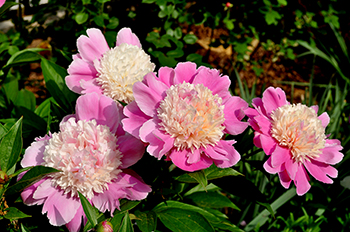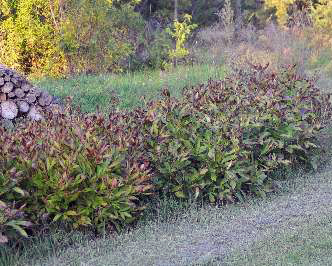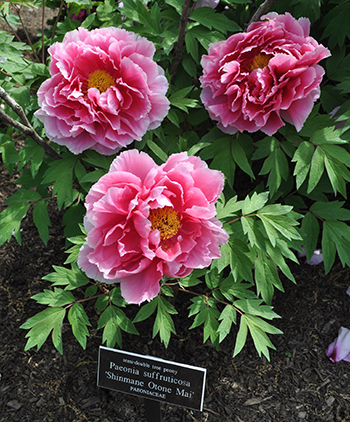Peonies: The ultimate pass-along plant
 Pass along plants are plants that are freely given from one person to another, or handed down from one generation to the next in families. One of the most frequently handed down plants is that old garden faithful, the peony. I know in my own garden I have three pass along peonies that came from Grandmother Patton’s garden. I am the third generation to grow them.
Pass along plants are plants that are freely given from one person to another, or handed down from one generation to the next in families. One of the most frequently handed down plants is that old garden faithful, the peony. I know in my own garden I have three pass along peonies that came from Grandmother Patton’s garden. I am the third generation to grow them.
The original peony bushes can still be found thriving on the Patton farm in southern Kansas, where they have received little or no care for well over 50 years. They have survived drought, floods, and total neglect. But each spring they reward with beautiful flowers in white, light pink and dark pink. Each time they flower in my garden I stop and reflect on my family history and the memories they bring.
I am sure I am not the only one that has pass-along plants in their garden, because of their longevity and ease of care. I believe that every garden should have at least one peony as the start of a new family tradition. Fall is the best time of the year to plant new peonies, divide clumps, or pass starts along to friends and family.
Growing peonies in Kansas City
There are three different groups of peonies that can be grown in Kansas City gardens;
- tree peonies,
- herbaceous, and
- intersectionals, crosses of tree and herbaceous.
Herbaceous and intersectionals are the easiest to grow and have the same culture — each fall they die back to the ground and new growth emerges in the spring. Tree peonies are in fact woody shrubs that go dormant over winter but new growth is renewed each spring on woody stems. They are not cut back to the ground in autumn but instead the stems are left to produce the flowers each spring.
Planting peonies in the fall
Peonies purchased in the fall are bare root plants that have been dug and divided. The peony actually grows from a tuber, which is a thick fleshy root. Each tuber will contain one or more big fat, pinkish-red bud or eye. This eye is the growing point of the plant and it must be handled with care during digging and planting. While the plant is not fussy to grow, the proper planting depth of the eye is important for long-term success. Planting the eye too deep or too shallow will result in poor flowering. The rule of thumb for planting is to place the tuber with the uppermost eye no more than 2 inches below the soil surface.
Location
Since peonies will remain in place for a number of years, or even decades, it is important to select the proper garden location. Peonies require full sun for best growth and good drainage. It is also a good idea to prepare a generous planting hole. Prepare an area about 18 inches in diameter and about the same depth. Add a generous amount of organic matter and work into the planting hole. A handful of bone meal or a couple tablespoons of 13-13-13 fertilizer worked into the hole will provide needed nutrients to help with establishment.
Begin filling the hole gently, settling the soil, and then place the tuber and continue backfilling, paying close attention to the depth of the eye. Once planted water thoroughly to settle the soil and double check the planting depth to ensure that the eye is located at the correct depth. Throughout the winter water if it’s dry, but little other care is needed. Peonies will start to emerge with new brilliant red growth in mid-March.
 Once established, peonies require very little care and they will thrive for years. It is recommended to remove the spent foliage each fall after it has yellowed. Fall removal will help reduce potential foliar disease problems. It is important not to remove the foliage until late in the season, as the green peony bush makes the energy needed for good flowering.
Once established, peonies require very little care and they will thrive for years. It is recommended to remove the spent foliage each fall after it has yellowed. Fall removal will help reduce potential foliar disease problems. It is important not to remove the foliage until late in the season, as the green peony bush makes the energy needed for good flowering.
Fertilizing peonies
If you wish, a light application of fertilizer can be made in the fall when cutting back the withered foliage. A follow up application can be made just as the new growth emerges in the spring. Outside of that no care is really needed. Of course, keeping down weeds and an occasional drink of water will improve the overall health of the plant and flowering.
 Herbaceous peonies are the easiest to find on the market and least expensive to purchase. They tend to have a fairly limited range of flower colors usually in white, various shades of pink and darker red shades. By crossing them with tree peonies, the newer, so-called intersectionals have greatly increased the color palette.
Herbaceous peonies are the easiest to find on the market and least expensive to purchase. They tend to have a fairly limited range of flower colors usually in white, various shades of pink and darker red shades. By crossing them with tree peonies, the newer, so-called intersectionals have greatly increased the color palette.
Tree peonies flower in the same color shades as the herbaceous but with more intensity and also in shades of yellow, corals and purple-red hues. By cross breeding, these new colors have been introduced into the easy-to-grow herbaceous peony line. Because they have been cross bred and also retain similar foliage, the tree types are grouped into the intersectional class. One word of caution about the newer varieties, they tend to cost a lot more.
This fall is your chance to start passing along memories. So either share a part of your established plants or purchase new ones to build a foundation for the future.
by Dennis Patton, horticulture agent
Have questions?
The Garden Hotline is staffed by trained EMG volunteers and Extension staff who will assist you with questions. Phone: (913) 715-7050. Email: garden.help@jocogov.org